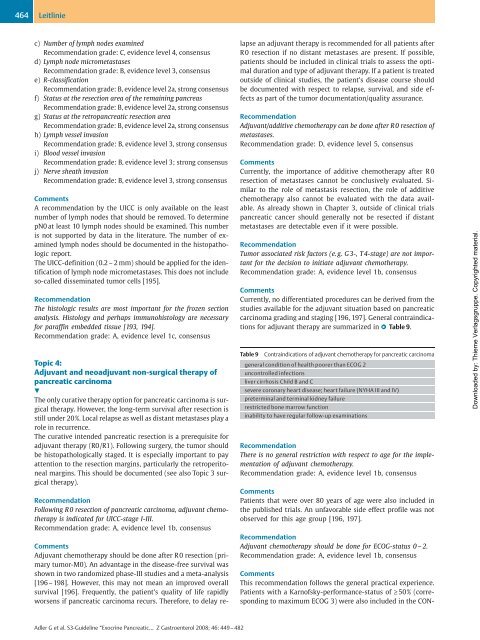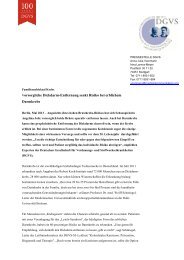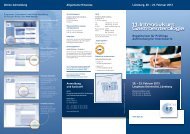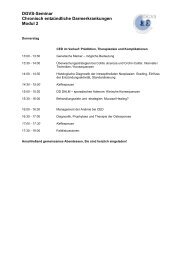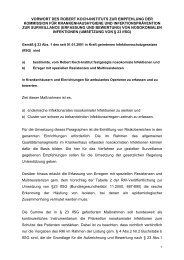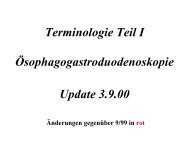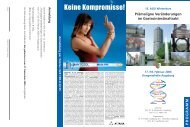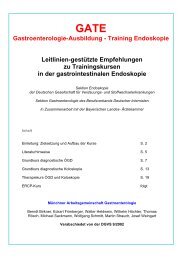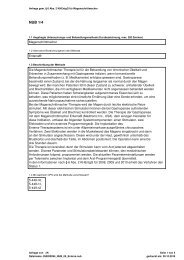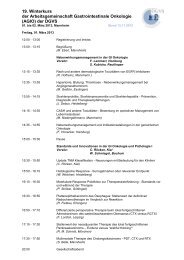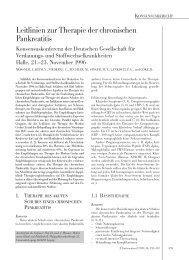S3-Guideline “Exocrine Pancreatic Carcinoma” 20071 ... - DGVS
S3-Guideline “Exocrine Pancreatic Carcinoma” 20071 ... - DGVS
S3-Guideline “Exocrine Pancreatic Carcinoma” 20071 ... - DGVS
Create successful ePaper yourself
Turn your PDF publications into a flip-book with our unique Google optimized e-Paper software.
464<br />
Leitlinie<br />
c) Number of lymph nodes examined<br />
Recommendation grade: C, evidence level 4, consensus<br />
d) Lymph node micrometastases<br />
Recommendation grade: B, evidence level 3, consensus<br />
e) R-classification<br />
Recommendation grade: B, evidence level 2a, strong consensus<br />
f) Status at the resection area of the remaining pancreas<br />
Recommendation grade: B, evidence level 2a, strong consensus<br />
g) Status at the retropancreatic resection area<br />
Recommendation grade: B, evidence level 2a, strong consensus<br />
h) Lymph vessel invasion<br />
Recommendation grade: B, evidence level 3, strong consensus<br />
i) Blood vessel invasion<br />
Recommendation grade: B, evidence level 3; strong consensus<br />
j) Nerve sheath invasion<br />
Recommendation grade: B, evidence level 3, strong consensus<br />
Comments<br />
A recommendation by the UICC is only available on the least<br />
number of lymph nodes that should be removed. To determine<br />
pN0 at least 10 lymph nodes should be examined. This number<br />
is not supported by data in the literature. The number of examined<br />
lymph nodes should be documented in the histopathologic<br />
report.<br />
The UICC-definition (0.2 – 2 mm) should be applied for the identification<br />
of lymph node micrometastases. This does not include<br />
so-called disseminated tumor cells [195].<br />
Recommendation<br />
The histologic results are most important for the frozen section<br />
analysis. Histology and perhaps immunohistology are necessary<br />
for paraffin embedded tissue [193, 194].<br />
Recommendation grade: A, evidence level 1c, consensus<br />
Topic 4:<br />
Adjuvant and neoadjuvant non-surgical therapy of<br />
pancreatic carcinoma<br />
!<br />
The only curative therapy option for pancreatic carcinoma is surgical<br />
therapy. However, the long-term survival after resection is<br />
still under 20%. Local relapse as well as distant metastases play a<br />
role in recurrence.<br />
The curative intended pancreatic resection is a prerequisite for<br />
adjuvant therapy (R0/R1). Following surgery, the tumor should<br />
be histopathologically staged. It is especially important to pay<br />
attention to the resection margins, particularly the retroperitoneal<br />
margins. This should be documented (see also Topic 3 surgical<br />
therapy).<br />
Recommendation<br />
Following R0 resection of pancreatic carcinoma, adjuvant chemotherapy<br />
is indicated for UICC-stage I-III.<br />
Recommendation grade: A, evidence level 1b, consensus<br />
Comments<br />
Adjuvant chemotherapy should be done after R0 resection (primary<br />
tumor-M0). An advantage in the disease-free survival was<br />
shown in two randomized phase-III studies and a meta-analysis<br />
[196 –198]. However, this may not mean an improved overall<br />
survival [196]. Frequently, the patient’s quality of life rapidly<br />
worsens if pancreatic carcinoma recurs. Therefore, to delay re-<br />
Adler G et al. <strong>S3</strong>-<strong>Guideline</strong> <strong>“Exocrine</strong> <strong>Pancreatic</strong>… Z Gastroenterol 2008; 46: 449–482<br />
lapse an adjuvant therapy is recommended for all patients after<br />
R0 resection if no distant metastases are present. If possible,<br />
patients should be included in clinical trials to assess the optimal<br />
duration and type of adjuvant therapy. If a patient is treated<br />
outside of clinical studies, the patient’s disease course should<br />
be documented with respect to relapse, survival, and side effects<br />
as part of the tumor documentation/quality assurance.<br />
Recommendation<br />
Adjuvant/additive chemotherapy can be done after R 0 resection of<br />
metastases.<br />
Recommendation grade: D, evidence level 5, consensus<br />
Comments<br />
Currently, the importance of additive chemotherapy after R 0<br />
resection of metastases cannot be conclusively evaluated. Similar<br />
to the role of metastasis resection, the role of additive<br />
chemotherapy also cannot be evaluated with the data available.<br />
As already shown in Chapter 3, outside of clinical trials<br />
pancreatic cancer should generally not be resected if distant<br />
metastases are detectable even if it were possible.<br />
Recommendation<br />
Tumor associated risk factors (e.g. G 3-, T 4-stage) are not important<br />
for the decision to initiate adjuvant chemotherapy.<br />
Recommendation grade: A, evidence level 1b, consensus<br />
Comments<br />
Currently, no differentiated procedures can be derived from the<br />
studies available for the adjuvant situation based on pancreatic<br />
carcinoma grading and staging [196, 197]. General contraindications<br />
for adjuvant therapy are summarized in l " Table 9.<br />
Table 9 Contraindications of adjuvant chemotherapy for pancreatic carcinoma<br />
general condition of health poorer than ECOG 2<br />
uncontrolled infections<br />
liver cirrhosis Child B and C<br />
severe coronary heart disease; heart failure (NYHA III and IV)<br />
preterminal and terminal kidney failure<br />
restricted bone marrow function<br />
inability to have regular follow-up examinations<br />
Recommendation<br />
There is no general restriction with respect to age for the implementation<br />
of adjuvant chemotherapy.<br />
Recommendation grade: A, evidence level 1b, consensus<br />
Comments<br />
Patients that were over 80 years of age were also included in<br />
the published trials. An unfavorable side effect profile was not<br />
observed for this age group [196, 197].<br />
Recommendation<br />
Adjuvant chemotherapy should be done for ECOG-status 0 – 2.<br />
Recommendation grade: A, evidence level 1b, consensus<br />
Comments<br />
This recommendation follows the general practical experience.<br />
Patients with a Karnofsky-performance-status of ‡ 50% (corresponding<br />
to maximum ECOG 3) were also included in the CON-<br />
Downloaded by: Thieme Verlagsgruppe. Copyrighted material.


